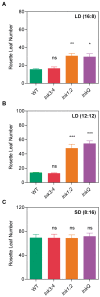The LNK Gene Family: At the Crossroad between Light Signaling and the Circadian Clock
- PMID: 30577529
- PMCID: PMC6356500
- DOI: 10.3390/genes10010002
The LNK Gene Family: At the Crossroad between Light Signaling and the Circadian Clock
Abstract
Light signaling pathways interact with the circadian clock to help organisms synchronize physiological and developmental processes to periodic environmental cycles. The plant photoreceptors responsible for clock resetting have been characterized, but signaling components that link the photoreceptors to the clock remain to be identified. Members of the family of NIGHT LIGHT⁻INDUCIBLE AND CLOCK-REGULATED (LNK) genes play key roles linking light regulation of gene expression to the control of daily and seasonal rhythms in Arabidopsis thaliana. Particularly, LNK1 and LNK2 were shown to control circadian rhythms, photomorphogenic responses, and photoperiod-dependent flowering time. Here we analyze the role of the four members of the LNK family in Arabidopsis in these processes. We found that depletion of the closely related LNK3 and LNK4 in a lnk1;lnk2 mutant background affects circadian rhythms, but not other clock-regulated processes such as flowering time and seedling photomorphogenesis. Nevertheless, plants defective in all LNK genes (lnkQ quadruple mutants) display developmental alterations that lead to increased rosette size, biomass, and enhanced phototropic responses. Our work indicates that members of the LNK family have both distinctive and partially overlapping functions, and are an essential link to orchestrate light-regulated developmental processes.
Keywords: NIGHT LIGHT–INDUCIBLE AND CLOCK-REGULATED; circadian activators; circadian clock; light signaling; phototropism.
Conflict of interest statement
The authors declare no conflict of interest.
Figures






References
-
- Blasing O.E., Gibon Y., Gunther M., Hohne M., Morcuende R., Osuna D., Thimm O., Usadel B., Scheible W.R., Stitt M. Sugars and circadian regulation make major contributions to the global regulation of diurnal gene expression in Arabidopsis. Plant Cell. 2005;17:3257–3281. doi: 10.1105/tpc.105.035261. - DOI - PMC - PubMed
Grants and funding
LinkOut - more resources
Full Text Sources
Molecular Biology Databases

